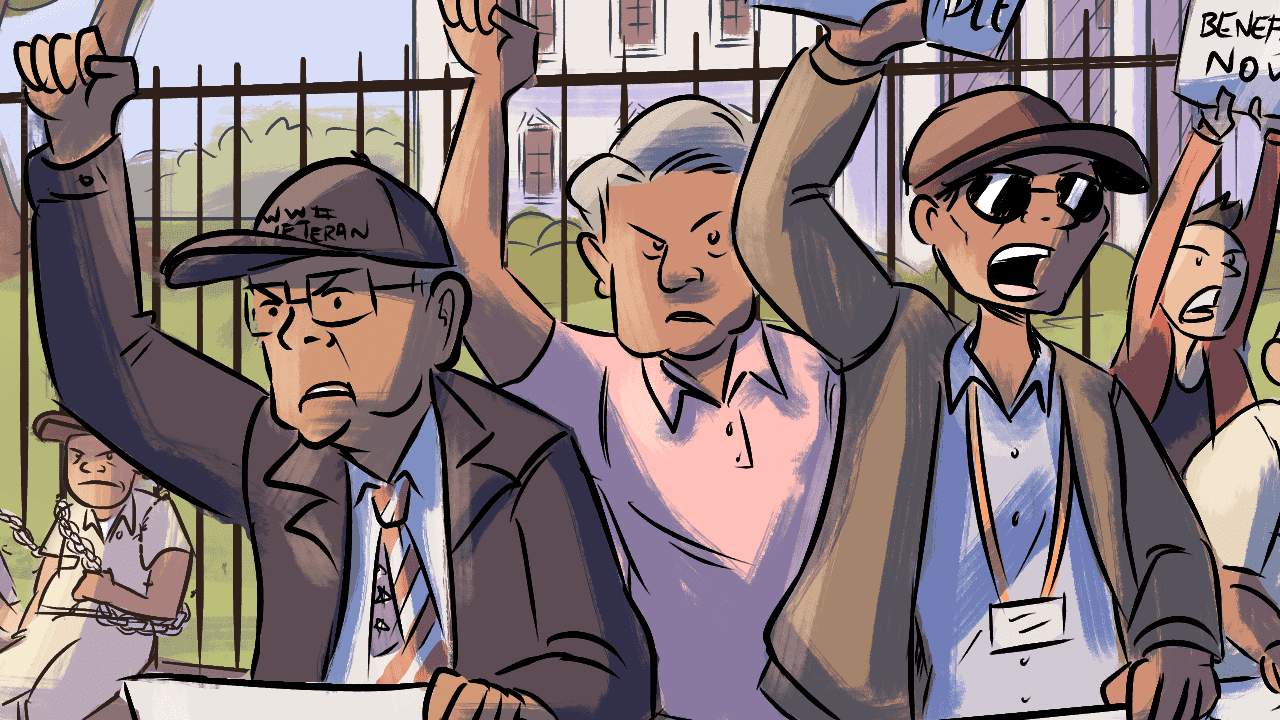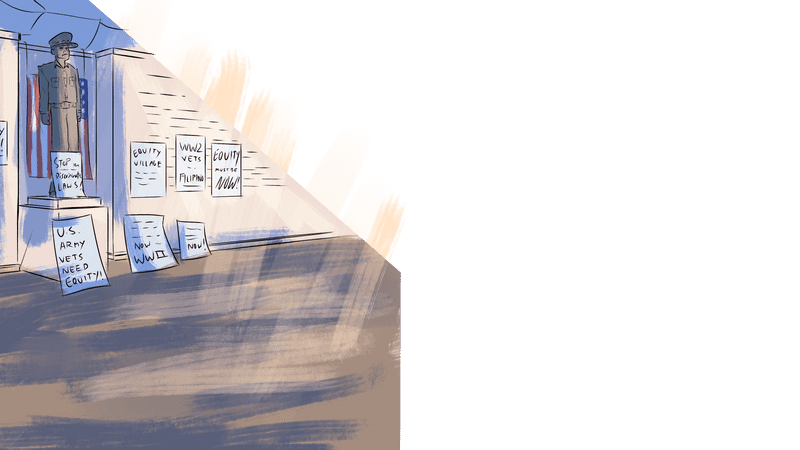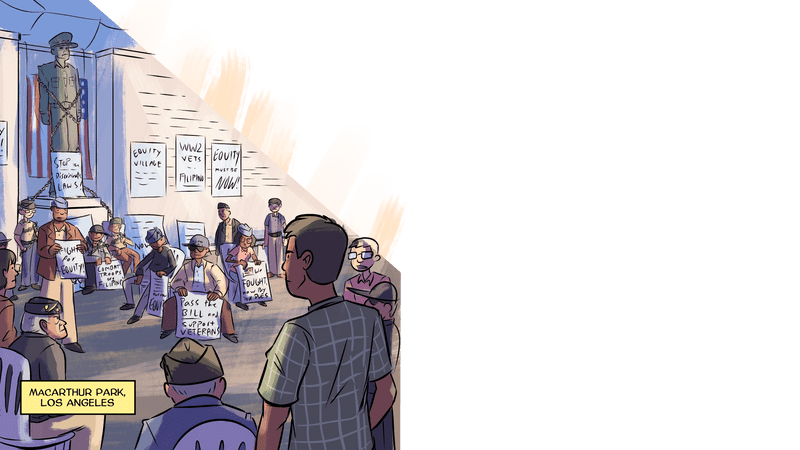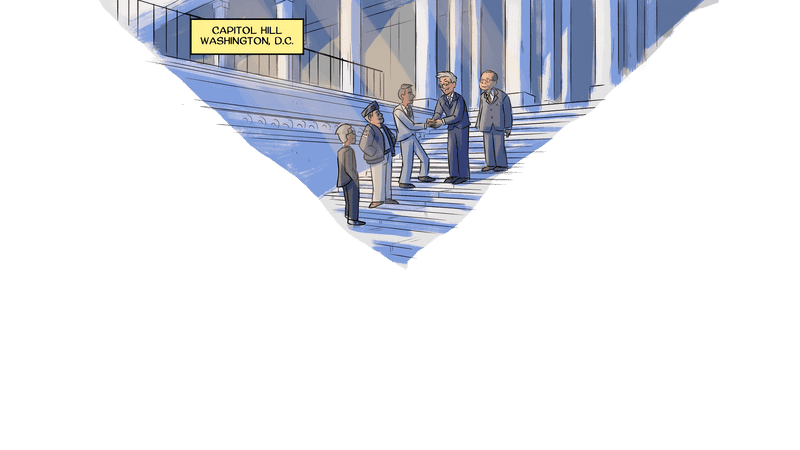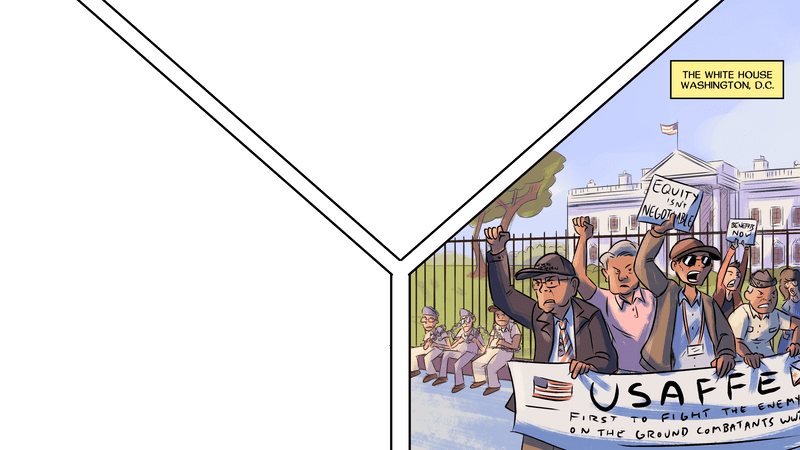Chapter Four: The Long Road to Equity
1997 – 2008
Taking to the Streets
On the streets and in newspapers, Filipino veterans raised their voices.
Citizenship was an important first step, but the battle for equity continued. On Capitol Hill, Senator Daniel Inouye introduced a Filipino Veterans Equity Bill every year for eighteen years straight. On the streets of American cities and the pages of American newspapers, Filipino veterans also raised their voices.
Among them was Patrick Ganio, who had fought at Corregidor in 1942 and was imprisoned as a POW at Camp O’Donnell. After he moved to the Washington DC area in the 1980s, he became an advocate for Filipino veterans. Ganio started at square one. He spent long hours at the Library of Congress studying the history, law, and politics of veterans affairs.
Pat Ganio
March 17, 1921 – June 15, 2019
WWII Veteran and Founder, American Coalition of Filipino Veterans
In 1942, Ganio survived both the fall of Corregidor and imprisonment in Japanese prisoner of war camps. Upon his release, Ganio joined the USAFFE guerrillas and was later wounded in battle. Postwar, Ganio served as a Major in the Philippine Army reserves and became a university educator. After 30 years, Ganio immigrated in the 1980s to the U.S. and began to organize and advocate for Filipino WWII veterans. He helped found the Filipino Veterans Families Foundation and the American Coalition of Filipino Veterans. Together they put pressure on the U.S. government to recognize the contribution of Filipino Veterans of WWII and restore benefits stripped by the 1946 Rescission Act. His decades of activism helped lead to several legislative victories, including the 2003 “Health Care for Filipino Veterans” bill.
From the ground up, he built a new organization, the American Coalition for Filipino Veterans, one of dozens of grassroots groups that emerged in the 1990s to make veterans’ voices heard. Ganio and others cheered in October 1996 when President Bill Clinton signed a Presidential Proclamation honoring them and thanking them for their wartime service. But they knew this was not enough.
Oral History
“Our first encounter is when we marched from the veterans' affair office to the White House.”
Celestino Almeda, WWII Veteran, 102 years old
In the summer of 1997, veterans and their allies staged protests, marches, and vigils. They launched political campaigns demanding full equity for veterans excluded by the Rescission Act. Activists in Los Angeles established the Equity Village encampment at MacArthur Park, a downtown site dedicated to the memory of General Douglas MacArthur.
There they staged a two-month sit-in and hunger strike. In Washington DC, veterans and Filipino Americans, joined by Representative Robert Filner (CA), chained themselves to the fence in front of the White House. They engaged in acts of civil disobedience, drawing attention to the justice of their cause.
That year, Filipino American community leaders formed the National Federation of Filipino American Associations (NaFFAA) to support the veterans’ demand for “equity and justice.” Veterans did not fight alone. A younger generation of Filipino Americans joined them.
Jon Melegrito
Journalist, activist leader, and advocate for Filipino Veterans benefits
Jon Melegrito has been a leading voice in the movement to win justice, equity, and recognition for Filipino veterans of WWII. Born in the Philippines, Melegrito immigrated to the U.S. with his parents in the 1960s. Already a community and social justice activist, Melegrito became active in the veterans’ movement after moving to Washington D.C. For Melegrito, his advocacy is also personal. He witnessed his father’s repeated denial of benefits by the Veterans Administration, despite the fact that his father was a USAFFE soldier who survived the Bataan Death March. For Melegrito it was clear: Filipino veterans were treated like “second-class citizens.” So, he joined and helped grow the veterans movement, from participating in demonstrations outside of the White House to walking the halls of Congress to garner support for the Filipino Veterans of World War II Congressional Gold Medal Act.
America is in the Heart
Some were relatives of veterans. They spoke up for their own lolos, or grandfathers, or for other manongs, or elders, in the community. Other young people were inspired by studying the issue in Asian American Studies courses. They connected the veterans’ efforts with other social justice movements by immigrants and people of color.
Oral History
“Can you imagine believing in something so much that you chain yourself to the white house knowing that you will be arrested?”
Rodney Salinas, Activist
Increasingly, the veterans found supporters across the political spectrum. National veterans groups endorsed their cause. From the Philippines, ambassadors and other diplomats continued to do their part. They leveraged decades of partnership between the U.S. and the Philippines to support the veterans.
On Capitol Hill, advocates such as Senator Daniel Inouye (HI) and Senator Daniel Akaka (HI) continued to face opposition from members of Congress who did not fully understand the history of World War II in the Philippines. Many did not recognize the need to fulfill the promises that the United States had made to more than 200,000 Filipinos who risked their lives to defend and liberate American territory from Japanese invaders.
Oral History
“Almost 3 times a week we trudged the halls of congress, teaching young congressmen the condition of Filipino WWII veterans.”
Celestino Almeda, WWII Veteran, 102 years old
Time and again, veterans felt their service was discounted or denied. But they pressed on. After being rejected at a 1998 congressional hearing, veterans spontaneously broke into singing “God Bless America,” reminding the United States to live up to its principles of justice and equality.
Bob Stump
April 4, 1927 – June 20, 2003
U.S. Representative and opponent of Filipino veterans’ benefits
As chairman of the House Committee on Veterans' Affairs, Bob Stump opposed efforts in the late 1990s to grant equity for Filipino veterans. In 1998, Stump presided over the House Veterans Affairs Committee’s debate regarding the Filipino Veterans Equity Act. This legislation would restore benefits to Filipino veterans and had nearly 200 sponsors in the House of Representatives. Stump, who had served in the Navy during the Pacific War, maintained that the Philippine government should be responsible for veterans’ benefits, not the United States. Though the Philippines was still a colonial possession of the U.S. during the war, Stump argued that Filipino veterans had fought for their own “soon-to-be independent Philippine nation.” Many veterans view Stump as one of their “primary foes” in their pursuit of benefits, as he almost single-handedly stonewalled veterans during his multi-year reign over the Veterans' Affairs Committee.
Occasionally, veterans won a few victories. They were able to obtain limited health and burial benefits. These small measures brought condemnation from veterans who felt they had waited long enough. “They want us to die first,” said Peping Baclig, a veteran from Los Angeles. “They don’t want us to live.” The tide was turning, but for the veterans, time was running out.
Oral History
“After the fire, they insisted they needed to get their military records. We're thinking, what paperwork could be so important that you have to risk your life? ”
Luisa Antonio, Executive Director of the Veterans Equity Center, Filipino Veterans Advocate
The tide was turning, but for the veterans, time was running out.
Next Section
2009
Bittersweet Victory
An Equity Fund would provide some benefits for thousands of living veterans, but it left the Rescission Act on the books.
Explore